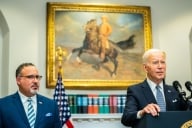You have /5 articles left.
Sign up for a free account or log in.

iStock/jorgenmac
Learning how to lead is also about learning how to balance the need for action with deliberative and deliberate approaches. It is quite correct to expect administrators, particularly in higher education, to demonstrate decisiveness in their decision-making behaviors. However, in far too many instances, in their haste to make things happen quickly, new deans mistake the ability to make swift decisions with effective leadership.
Quick fixes, or what are often referred to as “quick wins,” become entangled disasters and end up not serving anyone well. People forget the good they were meant to provide and are left with a sour taste in their mouths, simply because there was no consideration of impromptu actions designed to bring a nod of approval or some form of recognition.
Our own experiences have taught us that this haste, akin to a form of hacking, seldom if ever results in a reliable solution. Instead, we learned the value of “walking around a problem” in order to see and comprehend it from many different angles.
This strategy served us particularly well as black female deans whose decisions were subject to a great deal more scrutiny than was the case, certainly, with our white male colleagues and, to some extent, our white female peers as well. One of us, Carolyn, was the dean of the graduate school at the University of Tennessee. The other, Olga, was the dean of the School of Education at Duquesne University. We found that the strategy of walking around a problem, which we employed in our own contexts and, in turn, taught to those we supervised, underscored the importance of viewing the leadership role from multiple perspectives. For both of us, those different perspectives provided deliberate reminders that we occupied the role of dean, which would outlive both of our tenures in the role.
Therefore, it was incumbent on us to be in two places simultaneously -- that is, the present and the future. In the present, we dealt with the current responsibilities, challenges and expectations associated with the position. At the same time, we learned to use the future perspective as a lens through which to evaluate the impact of our decisions on the sustainability of the organization -- that is, the units we led. That required us to use the strategy of leading from behind to build integrity in the role. Thus, as much as possible, we led from behind by staying in role. For us, this meant viewing the deanship from the view of a sustained role and not merely as a position we happened to be occupying.
Staying in Role
As a strategy, staying in role involved deliberate steps to keep our egos and positions in separate places, particularly when making decisions or dealing with an especially important challenge. For example, in involving those we led in any change process related to the organization, we recognized that, even in the midst of change people fervently say they desire, they are in two places at the same time -- looking with hope, enthusiasm and energy toward the promise of change while simultaneously craving the security and safety of what already exists, even if keeping things unchanged negatively impacts or even negates progress.
Leading from behind meant remaining aware of this dichotomy and responding from our role as deans, not from our egos. Thus, we were both outside the role (future) and inside the role (present) as we navigated the business of administering our respective units. In executing the role of dean in this fashion, we hoped to ensure that we were both sustaining the institutions and the role, equipping both to continue to evolve in ways that would allow both schools to face future issues and challenges, and preserving their relevance amid the inevitable changing landscape of higher education. Although it was a difficult task, we made walking around a problem a component of our leadership behavior that we also taught to those we led. In both of our cases, engaging in strategic planning initiatives within our respective schools and with central administration represented one shared example of refusing to engage in autonomous decision making, masquerading as authentic attempts at collaborative deliberations.
Olga involved her leadership team and the School of Education faculty in crafting an identity that guided their strategic planning efforts moving forward. Similarly, as Carolyn sought to advance an agenda for the graduate school, she also engaged in deliberations with her staff, the deans of the institution’s multiple colleges and the graduate faculty across the university in designing the long-range planning needed to realize the shared goal of quality graduate education within the institution.
In each instance, we resisted attempts to settle too quickly on silver-bullet solutions or quick fixes, no matter how tempting the short-term benefits. This strategy was not without its cost to both units and to central administration in their efforts to address issues of student recruitment and university rankings and to accrue the necessary capital to develop strong academic program offerings. In choosing to operate differently, we were not naïve to those concerns, nor were we unaware of or unsympathetic to positioning our respective institutions and schools among their most favorable and advantageous higher education peers. But having been faculty members and administrators before becoming deans, we also had witnessed and participated in several strategic planning processes that achieved modest change but rarely the sustained or robust change these initiatives sought to foster.
Determined not to involve ourselves or those we led in processes destined to fail or, at best, provide inadequate short-term solutions, we opted instead for the strategy of walking around the problem as a way of acting that operationalized reflection before, during and after decision making related to strategic planning. Thus, for example, it was not unusual for the members of our leadership teams to defer action on a particular issue or challenge by invoking the statement “Why don’t we walk around this?” In doing so, they developed the habit of thinking about the short-term and long-term benefits as well as the potential pitfalls of any decision(s) they made.
Additionally, while engaging in this strategy, the members of the leadership teams also began to enact the strategy of staying in role -- that is, consciously attempting to keep their egos separate from their administrative positions. As deans, we reasoned and hoped that as ego and position became viewed as separate entities, it would become less likely that self-serving agendas or actions would be taken. While not always successful, the more often our leadership teams practiced this strategy, the less consciously and the more unconsciously it burrowed itself into their and our administrative behavior.
For us, walking around the problem meant more than giving deliberative thought and including broad-based input to developing action plans for achieving strategic goals. It also meant moving back and forth between the margins (as African-American women who were sometimes isolated and excluded) and the center (as deans) to fulfill the expectations of our positions. Circumstances often required us to adopt a stance that directly challenged a stereotypical view of African-Americans in general and African-American women in particular. Without belaboring the point, we refused to be typecast by those who directly reported to us, our administrative peers or the institutions that hired us. That meant making it clear at the outset that we intended to hold to our convictions in the face of overt and covert systemic bias and racism. Thus, those who worked with us and for us could predict that we would behave in ways that aligned with our personal codes of ethics. Adopting that stance did not make us paragons of virtue or martyrs. What it did make us was our own women, whose approbation or loyalty could not be bought.
Being clear about what you will not compromise is an important tool for any administrator, especially one of color. Why? Because people think they know you because they have studied how to interact with your particular racial and gender “box.” For that reason, they fail to take the time to learn about you, preferring instead to see you as a member of a group whose actions call for prescribed responses.
In our previous research collaborations, we learned the value that could be derived from standing outside on the inside -- that is, the ability to assume a “both/and perspective.” Thus, we walked around a problem from our vantage point as the participant in the situation (i.e., the leader) while also considering the perspectives of our faculty, staff, the students we served and our peer administrative colleagues. Though never a perfect strategy, consciously assuming the outsider viewpoint enabled us to appreciate the limitations of taking only our own view alone of a situation. Instead, we invited and even sought the gaze of others to inform our decision making and also to lessen the potential negative consequences of limiting that gaze to our own reflections or insights.
Lesson Learned
Our oppositional gaze and ability to embrace the margin and shuttle between margin and center became a source of enormous strength primarily because we had already determined that we would give our institutions our highest professional performance but never at the expense of our identities or our integrity. We knew that our ability to achieve the goals we set for our respective units could not occur if we were viewed as willing to sell our souls to enhance our own reputations, or advance our own agendas at the expense of our units.
In fact, in teaching doctoral students as full professors, both of us had stressed the need of, before graduation, identifying the one thing they would not forfeit, the thing for which they would leave a job rather than relinquish. We told them that this thing constituted their integrity (i.e., their soul), which could be sold only once, never to be fully regained. We also underscored that it was this very commodity that others would most seek out, albeit never with frontal attacks. Instead, attempts would be made to locate their price and thereby acquire their souls. The price might be a promotion, additional opportunities to represent the institution, increases in salaries -- in short, anything that could be used as a blandishment. To be sure, all of us engage in compromises daily, even going home and rebuking ourselves for letting those pieces go, yet we were determined to stop short of selling pieces of our integrity in exchange for a title or reward that did little to enhance our purpose or well-established portfolios. The major, core piece -- that is, our academic and professional identities and ethics -- had to be guarded at all costs, because once sold, it cannot be retrieved.
Regardless of the organization, the need to control others is a strategy with universal appeal, particularly for those seeking to handle their bosses, supervisors or, in the case of the academy, deans. Thus, even when tempted to compromise one’s integrity in service to a higher goal, it’s useful to remember that people respect authenticity and long for people who will act principally, even if the same people disagree with or do not support the decision. Knowing that an administrator can be counted on to deal ethically, regardless of the circumstances and, most important, in the best interest of the organization, is reassuring for all those who must depend on that administrator’s decisions to advance their own professional careers, including attracting, hiring and, above all, retaining the right stuff as colleagues.
We want to emphasize that the lesson of walking around a problem is a learned one, just as staying in role must be practiced to achieve consistency. Moreover, we want to assure our readers that we had to remind ourselves constantly that it was not about us! As human beings, we craved authentic recognition of our efforts and were disappointed when it failed to occur.
That said, the consolation we derived from reminding ourselves that the organization, the people who depended on our leadership and the vision for change that in partnership with them we forged compensated in immeasurable ways. To paraphrase Sun Tzu in The Art of War, we came to believe that the best leaders are those who, when the task is completed, take satisfaction from hearing those they’ve led say, “We did it ourselves.”








